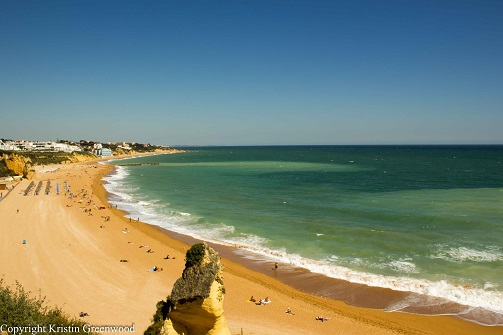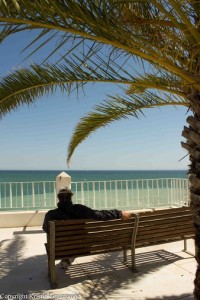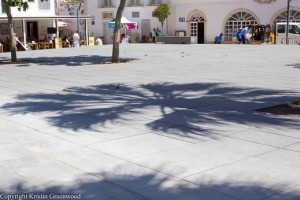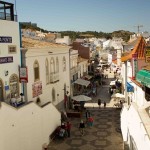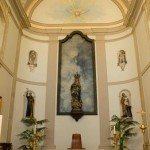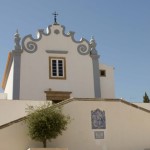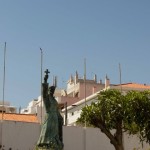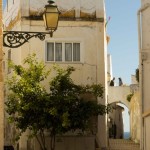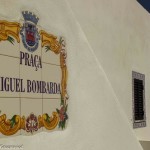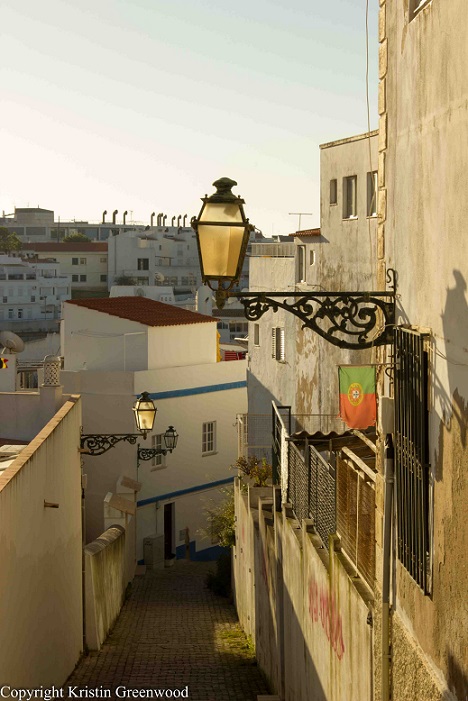Albufeira is known for being the capital of tourism. Every year around 5 million tourists visit the town with its wonderful sandy beaches in the Algarve, Portugal. The figure takes on a greater significance in comparison to the number of people who are actual residents there during the entire year – just 40,000 people.
As we are travelling on a budget Albufeira was the perfect starting point for our nomadic life. Compared to the high season, the hotel prices were very good when we went just after Easter in April. We stayed there for three weeks and when we came to the end of our stay, we decided to take an historic tour around the old town. Historic plus Albufeira seemed a rather unusual combination especially as we were visiting during the time when many tourists visit Albufeira for stag or hen nights.
Albufeira has seen other foreign occupiers over the years. The list includes the Barbarians, Romans, Moors and others. The Romans developed the agriculture in the Algarve and the Moorish highly influenced the architecture in the area. This is something that you can still see from the old buildings in the Algarve like the famous chimneys. Albufeira used to be an old fisherman’s village and fish was its main source of income aside from dried fruits or almonds. It also used to have a castle and this is the reason why it was called Albufeira, originating from the Arab word Al-Buhera, meaning “The Castle of the Sea”. Unfortunately the castle and many other buildings were destroyed by the big earthquake in 1755. Only 27 houses survived this big natural catastrophe. The development of the tourism started in the sixties.
Our guide, Cristiano, was someone local who was born in the old hospital of Albufeira before it was closed down. One of the first points he showed us was the central square within the old town. The square was surrounded by restaurants, pubs and cafes and inside the square was basically nothing but concrete stones. There were some workers digging up the road and a few tourists walking by or sitting on the side lines of the square.
The square felt rather cold and without character. With the exception of some street performers in the evening, it is apparently hardly being used in comparison with years ago when it was our guide’s favourite place for family events before the gardens were removed and the concrete arrived. The square used to be the Albufeira Garden and he explained to us that it was a very green area, filled with flowers, grass and more trees.
The Garden had provided a useful place of shade during some hot summer days with temperatures reaching 37 degrees and more. Cristiano remembered coming here with his parents and spending some relaxed quality time at the square. The question was what had happened? There was no earthquake or anything similar. Did an evil witch visit Albufeira and decided to take its green heart? Not quite unless you would compare bureaucrats to witches. In 1995 some bureaucrats in the city hall decided that this garden was a waste of money and so they took away the beautiful garden and ended up with the concrete bricks.
Cristiano seemed a little bit heartbroken over the state of the square. Later on the tour, we visited the archaeological museum and he showed us a picture of the former Albufeira Garden and it looked exactly the way he described it. Just like an oasis.
If you are going out at night, you can see quite a difference between the strip and the old town. The strip is more about partying and the old town has a more relaxed atmosphere. A fact which is also confirmed by the different age groups visiting the two areas.
On our way to the old Parish Church, we saw the tunnel linking the centre of Albufeira to the beach. The tunnel was built in the thirties and its construction was quite controversial as it was built into a rock so the people thought it was not safe enough. The next controversial construction was when Albufeira’s first hotel called Sol e Mar was built just on top of the tunnel in the fifties. The hotel name means sun and sea because it just overlooking the sea and one can have some beautiful views from there.
– Click on the picture to see the entire picture –
- View above the tunnel into Albufeira old town
- Inside the Parish Church
- Santa Ana Church
- St. Vincent Statue
The original Parish Church also collapsed during the earthquake of 1755. When the original church collapsed a lot of people died because they searched for protection inside the church. It was rebuilt in 1782. Normally the churches in Portugal are built and named for a saint, however, in this case the church was named after the people because the people rebuilt it. It is the people’s church. It has a neo-classical style of architecture with a cross on top of the door representing the religious leader who was in charge of Albufeira. Inside the church you can see a lot of saints. In Portugal they have saints for everything.
The Parish church has a smaller chapel inside which is used during the week for the masses as it is not so busy. During the weekend, the masses are held inside the main church area and it is usually very packed.
After the Parish Church, we saw the Santa Ana Church which was built in the 18th century. It was not open for public. Shortly after the Santa Ana Church came the St. Vincent statue. St Vincent was a local saint because he was born in 1590 in Albufeira. However, he did not live in Albufeira during most of his life. He grew up in Lisbon and became an expert in areas like literature, music and his main passion in life was to share the god’s word. Like us St. Vincent travelled around the world. However we hope not to meet the same fate he did…
St. Vincent visited many places in Europe. He was in Mexico until his word was not accepted there and he was expelled. His last stop was in Japan where he was locked up for 2 years. He was tortured to give up his Christian beliefs and then burned alive on 3rd of September 1632. The locals have a special mass in the Parish Church to honor St. Vincent every year on 3rd of September.
– Click on the picture to see the entire picture-
- Store in Albufeira – see what it says underneath PIRI
- Side Street in Albufeira
- Sign of Praca Miguel Bombarda
Once we passed the statute, we walked along some pretty streets to the Peneco Beach view point. A perfect view point to oversee Albufeira in the afternoon or evening. The air smelled of fresh fish and sea. The water in the sea showed two types of colours because 2 years ago, the Portuguese extracted sand of the sand banks and brought it in smaller boats to the sea to make the coast bigger.
On our way down, we saw a few other points before our bus took us back to the hotel. All in all the combination of Albufeira and historical works to certain extend. We found the best part of the tour was when we walked along the little streets around the area where the castle once stood. We wished we could have enjoyed the original Albufeira Garden and certainly hope that the bureaucrats or any other wicked disasters do not destroy the older parts that remain.
Click here – Portugal Official Tourism Website

